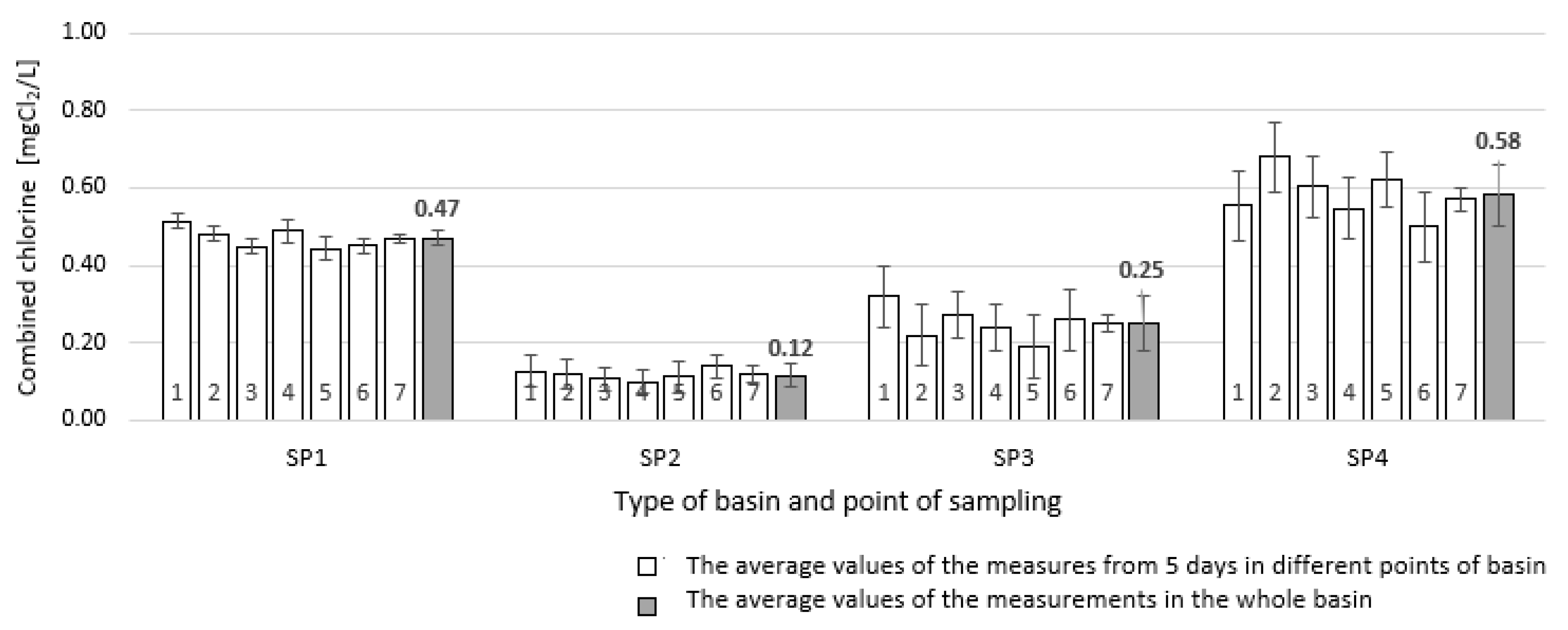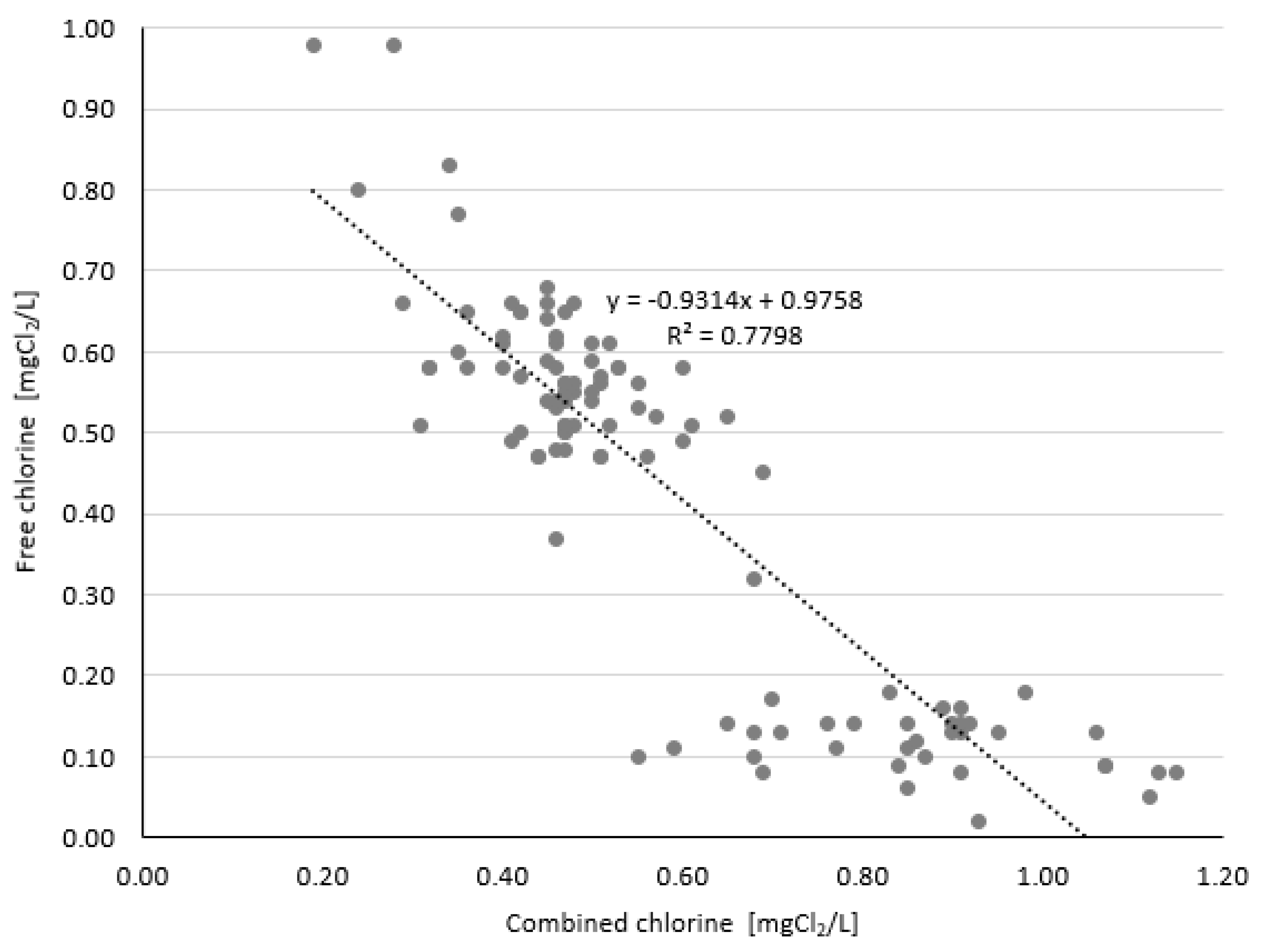Analysis of Free and Combined Chlorine Concentrations in Swimming Pool Water and an Attempt to Determine a Reliable Water Sampling Point
Abstract
:1. Introduction
2. Materials and Methods
2.1. Characteristics of Research Objects
2.2. Water Samples
2.3. Chlorine and Additional Parameters Measurement
3. Results and Discussion
4. Summary and Conclusions
Author Contributions
Funding
Conflicts of Interest
References
- World Health Organization. Guidelines for Safe Recreational Water Environments; Swimming Pools and Similar Environments; WHO: Geneva, Switzerland, 2006; Volume 2, Available online: http://www.who.int/water_sanitation_health/bathing/srwe2full.pdf (accessed on 22 March 2019).
- Tang, H.L.; Ristau, R.J.; Xie, Y.F. Disinfection By-Products in Swimming Pool Water: Formation, Modeling, and Control; American Chemical Society: Washington, DC, USA, 2015; pp. 381–403. [Google Scholar] [CrossRef]
- Tang, H.L.; Ristau, R.J.; Xie, Y.F.; Simard, S.; Tardif, R.; Rodriguez, M.J.; Catto, C.; Charest-Tardif, G.; Simard, S. Variability of Chlorination By-Product Occurrence in Water of Indoor and Outdoor Swimming Pools. Water Res. 2013, 47, 1763–1772. [Google Scholar] [CrossRef]
- Chowdhury, S.; Alhooshani, K.; Karanfil, T. Disinfection Byproducts in Swimming Pool: Occurrences, Implications and Future Needs. Water Res. 2014, 53, 68–109. [Google Scholar] [CrossRef]
- Tardif, R.; Rodriguez, M.; Catto, C.; Charest-Tardif, G.; Simard, S. Concentrations of Disinfection By-Products in Swimming Pool Following Modifications of the Water Treatment Process: An Exploratory Study. J. Environ. Sci. 2017, 58, 163–172. [Google Scholar] [CrossRef]
- Lee, J.; Jun, M.J.; Lee, M.H.; Lee, M.H.; Eom, S.W.; Zoh, K.D. Production of Various Disinfection Byproducts in Indoor Swimming Pool Waters Treated with Different Disinfection Methods. Int. J. Hyg. Environ. Health 2010, 213, 465–474. [Google Scholar] [CrossRef]
- Carter, R.A.A.; Joll, C.A. Occurrence and Formation of Disinfection By-Products in the Swimming Pool Environment: A Critical Review. J. Environ. Sci. 2017, 58, 19–50. [Google Scholar] [CrossRef] [PubMed] [Green Version]
- Ilyas, H.; Masih, I.; van der Hoek, J. Disinfection Methods for Swimming Pool Water: Byproduct Formation and Control. Water 2018, 10, 797. [Google Scholar] [CrossRef] [Green Version]
- Ilyas, H.; Masih, I.; van der Hoek, J. An Exploration of Disinfection By-Products Formation and Governing Factors in Chlorinated Swimming Pool Water. J. Water Health 2018, 16, 861–892. [Google Scholar] [CrossRef] [PubMed]
- Orlov, V.; Zotkin, S.; Pelipenko, A. Mathematical Modelling of Water Exchange in Public Swimming Pools. IOP Conf. Ser. Mater. Sci. Eng. 2018, 365, 042016. [Google Scholar] [CrossRef]
- Gomà, A.; de Lluis, R.; Roca-Ferrer, J.; Lafuente, J.; Picado, C. Respiratory, Ocular and Skin Health in Recreational and Competitive Swimmers: Beneficial Effect of a New Method to Reduce Chlorine Oxidant Derivatives. Environ. Res. 2017, 152, 315–321. [Google Scholar] [CrossRef]
- Li, J.H.; Wang, Z.H.; Zhu, X.J.; Deng, Z.H.; Cai, C.X.; Qiu, L.Q.; Chen, W.; Lin, Y.J. Health Effects from Swimming Training in Chlorinated Pools and the Corresponding Metabolic Stress Pathways. PLoS ONE 2015, 10, e0119241. [Google Scholar] [CrossRef]
- Pándics, T.; Hofer, Á.; Dura, G.; Vargha, M.; Szigeti, T.; Tóth, E. Health Risk of Swimming Pool Disinfection By-Products: A Regulatory Perspective. J. Water Health 2018, 16, 947–957. [Google Scholar] [CrossRef] [PubMed]
- Van Veldhoven, K.; Keski-Rahkonen, P.; Barupal, D.K.; Villanueva, C.M.; Font-Ribera, L.; Scalbert, A.; Bodinier, B.; Grimalt, J.O.; Zwiener, C.; Vlaanderen, J.; et al. Effects of Exposure to Water Disinfection By-Products in a Swimming Pool: A Metabolome-Wide Association Study. Environ. Int. 2018, 111, 60–70. [Google Scholar] [CrossRef] [PubMed] [Green Version]
- De Laat, J.; Feng, W.; Freyfer, D.A.; Dossier-Berne, F. Concentration Levels of Urea in Swimming Pool Water and Reactivity of Chlorine with Urea. Water Res. 2011, 45, 1139–1146. [Google Scholar] [CrossRef] [PubMed]
- Teo, T.L.L.; Coleman, H.M.; Khan, S.J. Chemical Contaminants in Swimming Pools: Occurrence, Implications and Control. Environ. Int. 2015, 76, 16–31. [Google Scholar] [CrossRef] [PubMed]
- Gallè, F.; Dallolio, L.; Marotta, M.; Raggi, A.; Di Onofrio, V.; Liguori, G.; Toni, F.; Leoni, E. Health-Related Behaviors in Swimming Pool Users: Influence of Knowledge of Regulations and Awareness of Health Risks. Int. J. Environ. Res. Public Health 2016, 13, 513. [Google Scholar] [CrossRef] [Green Version]
- Liguori, G.; Capelli, G.; Carraro, E.; Di Rosa, E.; Fabiani, L.; Leoni, E.; Marensi, L.; Napoli, C.; Pasquarella, C.; Romano Spica, V.; et al. A New Checklist for Swimming Pools Evaluation: A Pilot Study. Microchem. J. 2014, 112, 181–185. [Google Scholar] [CrossRef]
- Zarzoso, M.; Llana, S. Potential Negative Effects of Chlorinated Swimming Pool Attendance on Heath of Swimmers and Associated Staff. Biol. Sport 2010, 27, 233–240. [Google Scholar] [CrossRef] [Green Version]
- Barna, Z.; Kádár, M. The Risk of Contracting Infectious Diseases in Public Swimming Pools. A Review. Annali dell’Istituto Superiore di Sanità 2012, 48, 374–386. [Google Scholar] [CrossRef]
- Cloteaux, A.; Gérardin, F.; Midoux, N. Influence of Swimming Pool Design on Hydraulic Behavior: A Numerical and Experimental Study. Engineering 2013, 05, 511–524. [Google Scholar] [CrossRef] [Green Version]
- Saunus, C. Planug von Schwimmbadern (Planning of Swimming Pools); Krammer Verlag Dusseldorf AG: Dusseldorf, Germany, 1998. [Google Scholar]
- Wei, X.; Li, J.; Hou, S.; Xu, C.; Zhang, H.; Atwill, E.; Li, X.; Yang, Z.; Chen, S. Assessment of Microbiological Safety of Water in Public Swimming Pools in Guangzhou, China. Int. J. Environ. Res. Public Health 2018, 15, 1416. [Google Scholar] [CrossRef] [Green Version]
- Guida, M.; Di Onofrio, V.; Gallè, F.; Gesuele, R.; Valeriani, F.; Liguori, R.; Romano Spica, V.; Liguori, G. Pseudomonas Aeruginosa in Swimming Pool Water: Evidences and Perspectives for a New Control Strategy. Int. J. Environ. Res. Public Health 2016, 13, 919. [Google Scholar] [CrossRef] [PubMed] [Green Version]
- Aboulfotoh Hashish, N.M.; Gawad Abbass, A.A.; Khamis Amine, A.E. Pseudomonas Aeruginosa in Swimming Pools. Cogent Environ. Sci. 2017, 3. [Google Scholar] [CrossRef]
- Wyczarska-Kokot, J.; Lempart, A.; Dudziak, M. Chlorine Contamination in Different Points of Pool—Risk Analysis for Bathers’ Health. Ecol. Chem. Eng. A 2017, 24, 217–226. [Google Scholar] [CrossRef]
- Wyczarska-Kokot, J. The Problem of Chloramines in Swimming Pool Water—Technological Research Experience. Desalin. Water Treat. 2018, 134, 7–14. [Google Scholar] [CrossRef]
- Lempart, A.; Kudlek, E.; Dudziak, M. Determination of Micropollutants in Water Samples from Swimming Pool Systems. Water 2018, 10, 1083. [Google Scholar] [CrossRef] [Green Version]
- DIN 19643. Water Treatment for Swimming and Bathing Pools; Beuth-Verlag: Berlin/Düsseldorf, Germany, 2012. (In German) [Google Scholar]
- RCL. Decree of the Health Minister on the Requirements for Water in Swimming Pools; Dz. U. of 2015, Item 2016; RCL: Warsaw, Poland, 2015. Available online: http://isap.sejm.gov.pl/DetailsServlet?id=WDU20150002016 (accessed on 22 March 2019). (In Polish)







| Swimming Pool | SP1 | SP2 | SP3 | SP4 |
|---|---|---|---|---|
| Function of basin | sport and recreation | sport and recreation with hydromassage | swimming lessons (school pool) | sport and recreation |
| Type of basin | indoor | outdoor | indoor | indoor |
| Dimensions of the pool basin, m × m | 12.5 × 25 | 12.4 × 25 | 7.2 × 12.5 | 10 × 25 |
| Depth of the pool basin, m | 1.1–1.8 | 1.2 | 1.2 | 1.35–2.80 |
| Volume of the pool basin, m3 | 453 | 342 | 162 | 576 |
| Usable area (UA), m2 | 312.5 | 285.0 | 90.0 | 250.0 |
| Attendance, person/h | 16–18 | 34–54 | 20–25 | 15–20 |
| Actual UA, m2/person | 17.4–19.5 | 5.3–8.4 | 3.6–4.5 | 12.5–16.6 |
| Filter type | pressure, closed | vacuum, open, washed with diatomaceous earth | pressure, closed | pressure, closed |
| Number of filters | 2 | 1 | 2 | 2 |
| Filter size, mm | Ø 2000 | 4183 × 1870 × 1500 | Ø 630 | Ø 1600 |
| Type of filter bed | sand-anthracite | diatomite (diatomaceous earth) | sand-anthracite | sand-anthracite |
| Filtration flow, m3/h | 188.6 | 123.0 | 40.5 | 121.3 |
| Filtration velocity, m/h | 30 | 5 | 30 | 30 |
| The time of one water change in the pool basin, h | 2.4 | 2.8 | 4.0 | 4.75 |
| Hydraulic system of the water flow | vertical | vertical | horizontal with nozzles in the long pool wall | horizontal with nozzles in the short pool wall |
| Disinfection method | 14.5% stabilized solution of NaOCl, automatic dosage (2 mg/L/h) and control to get a concentration 0.3–0.6 mg Cl2/L + low pressure UV lamp (600 J/m2) | 14.5% stabilized solution of NaOCl, automatic dosage (2 mg/L/h) and control to get a concentration 0.7–1.0 mg Cl2/L + low pressure UV lamp (600 J/m2) | 14.5% stabilized solution of NaOCl, automatic dosage (2 mg/L/h) and control to get a concentration 0.3–0.6 mg Cl2/L | 14.5% stabilized solution of NaOCl, automatic dosage (2 mg/L/h) and control to get a concentration 0.3–0.6 mg Cl2/L |
| Parameter, Units | SP1 | SP2 | SP3 | SP4 |
|---|---|---|---|---|
| Redox potential, mV | 664 | 714 | 634 | 628 |
| Nitrate content, mg NO3−/L | 2.8 | 2.7 | 3.0 | 3.5 |
| Turbidity, NTU | 0.18 | 0.19 | 0.18 | 0.20 |
| Chemical oxygen demand—COD, mg O2/L | 1.55 | 0.53 | 1.54 | 1.53 |
| Total trihalomethanes—THM, mg/L | 0.040 | 0.040 | 0.040 | 0.041 |
| Total organic carbon—TOC, mg C/L | 3.29 | 0.72 | 7.12 | 9.26 |
© 2020 by the authors. Licensee MDPI, Basel, Switzerland. This article is an open access article distributed under the terms and conditions of the Creative Commons Attribution (CC BY) license (http://creativecommons.org/licenses/by/4.0/).
Share and Cite
Wyczarska-Kokot, J.; Lempart-Rapacewicz, A.; Dudziak, M. Analysis of Free and Combined Chlorine Concentrations in Swimming Pool Water and an Attempt to Determine a Reliable Water Sampling Point. Water 2020, 12, 311. https://doi.org/10.3390/w12020311
Wyczarska-Kokot J, Lempart-Rapacewicz A, Dudziak M. Analysis of Free and Combined Chlorine Concentrations in Swimming Pool Water and an Attempt to Determine a Reliable Water Sampling Point. Water. 2020; 12(2):311. https://doi.org/10.3390/w12020311
Chicago/Turabian StyleWyczarska-Kokot, Joanna, Anna Lempart-Rapacewicz, and Mariusz Dudziak. 2020. "Analysis of Free and Combined Chlorine Concentrations in Swimming Pool Water and an Attempt to Determine a Reliable Water Sampling Point" Water 12, no. 2: 311. https://doi.org/10.3390/w12020311





